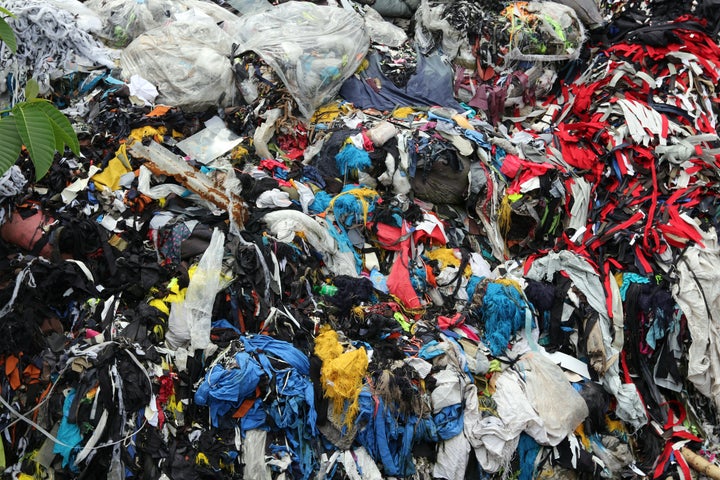
Fast fashion and sustainability: We often hear these two terms grouped together, with the former being to blame for hindering the latter.
Most of us fundamentally know there’s a price to pay for super affordable clothes. Consumers aren’t just paying money to add items to their cart ― they’re also paying an environmental and human toll.
But is fast fashion truly the only entity to blame? Or should we really be pointing the finger at ourselves, the ones buying and tossing out the fast fashion? Surely there’s more we can do as consumers.
The fundamental problems with the fast fashion industry
Most people define “fast fashion” as the brands that seem to crank out new collections every other week, or that produce designer dupes at lightning speed.
“I consider myself an ex-fast fashion addict,” says environmental educator Elizabeth Teo. “I was drawn in by the sales and the ‘fun’ experience of going to the mall weekly with friends and family and trying on clothes.”
“More than 50% of fast fashion garments are disposed of within a year of being produced.”
It wasn’t until Teo watched the 2015 film “The True Cost” that her fashion mindset shifted. The movie takes a global look at the environmental impact of the consumption of clothes, as well as the dangerous conditions and low pay that garment workers are subjected to, just to make a $15 shirt feasible.
The Council for Textile Recycling estimates the average American discards 70 pounds of textiles and clothes every year. There’s no breakdown of that data in terms of which types of clothes are being discarded, but a 2017 report by the Ellen MacArthur Foundation revealed that more than 50% of fast fashion garments are disposed of within a year of being produced.
As a whole, “the fashion industry is one of the most environmentally damaging sectors in the global economy, using a tremendous amount of energy and water and polluting our planet,” said Erin Wallace, vice president of integrated marketing at ThredUp, a clothing resale site.

In 2018 alone, the worldwide fashion industry contributed 2.1 billion metric tons of greenhouse gas emissions. That’s comparable to the total emissions of the U.K., France and Germany combined. That same year, the Environmental Protection Agency estimates 11.3 million tons of textiles, the majority of it in the form of clothing, went to landfills.
And even before the waste is produced, the 70 million people employed in the worldwide garment industry, many of whom are women, pay a price. It’s been widely reported that the workers who produce the clothes and shoes we wear commonly face issues of exploitation and forced labor.
And even if you try to get more life out of your fast fashion, it’s not easy. While online consignment and thrift shops have seen a major uptick during the pandemic, Wallace says ThredUp prefers not to accept fast fashion brands.
“Clothing that’s cheaply made and poorly constructed just isn’t created to withstand multiple wears,” she said.
Fast fashion isn’t the only culprit
Most consumers are presumably more willing to toss or donate a $10 summer dress than an old Céline bag. But other brands, even luxury labels, aren’t exactly earth-friendly.
Burberry came under fire in 2018 for burning almost $40 million in unsold stock, in order to prevent discounted goods from being sold and possibly watering down the brand’s high-end appeal.
The United Nations Environment Programme estimates that every second, the equivalent of a garbage truck of textiles is burned or disposed of in landfills. And the fashion industry as a whole contributes 20% and 10% of the world’s wastewater and carbon emissions, respectively.
Overproduction and consumption are the main issues, whether it’s the 70 pounds every year from individual Americans or the brands burning goods that can’t be sold.
But what’s the fix?
The pandemic has brought a surge of attention and donations for online consignment and thrift shops. One potential solution is for consumers and the industry alike to become better at recycling and reusing fast fashion.
“We believe resale is the circular solution to the traditional fashion industry’s linear ‘take-make-dispose’ model,” Wallace said. “The more consumers embrace secondhand, the less demand there will be for new clothing production.”
ThredUp estimates it has diverted more than 100 million items from landfills since the service was founded in 2009.

Poshmark is another popular resale site that’s usually packed with fast fashion, as well as mid-priced brands that are on trend and the occasional designer find. Goodwill’s online auction site, which also resells fast fashion among many other things, recently passed the $1 billion sales mark.
Teo, on the other hand, believes the key to a sustainable future is simply buying less. “That way there’s less stuff to get rid of.” This can mean shopping your closet or even repairing slightly damaged clothes.
Francisco Diaz is a Phoenix-based creative who describes himself as a slow fashion sewist, frequently sharing styling tips and videos on his Instagram. He’s a fan of remixing the “old” into something new and fly. “Reacquaint yourself with mending and altering and caring for a garment instead of throwing it right away,” he suggested.
Both Teo and Diaz also encourage shoppers to do their own research. While more and more brands are using the term “sustainable,” or even offer discounts for dropping off items in the store’s recycling bin, the brands aren’t always fully transparent about their intentions.
“Many brands nowadays have takeback programs for clothing, but where does it really go?” Teo said.
With regard to brands that label themselves as sustainable, Diaz suggests: “Dig into their production line and if it’s not stated anywhere, that may be a red flag. Where is the material coming from? Who is doing the labor to sew these items together?”
Whatever shoppers choose, “it’s work! You have to relearn how to shop,” said Diaz, who ditched fast fashion last year.
“If you’re looking to move away from fast fashion, it’s OK to start slowly,” he said. “There are no perfect consumers out there.”